Looking for a fresh flavor to try out on your homemade kombucha? This Mango Kombucha recipe is easy to brew and makes for a perfect balance between sweet and tart!
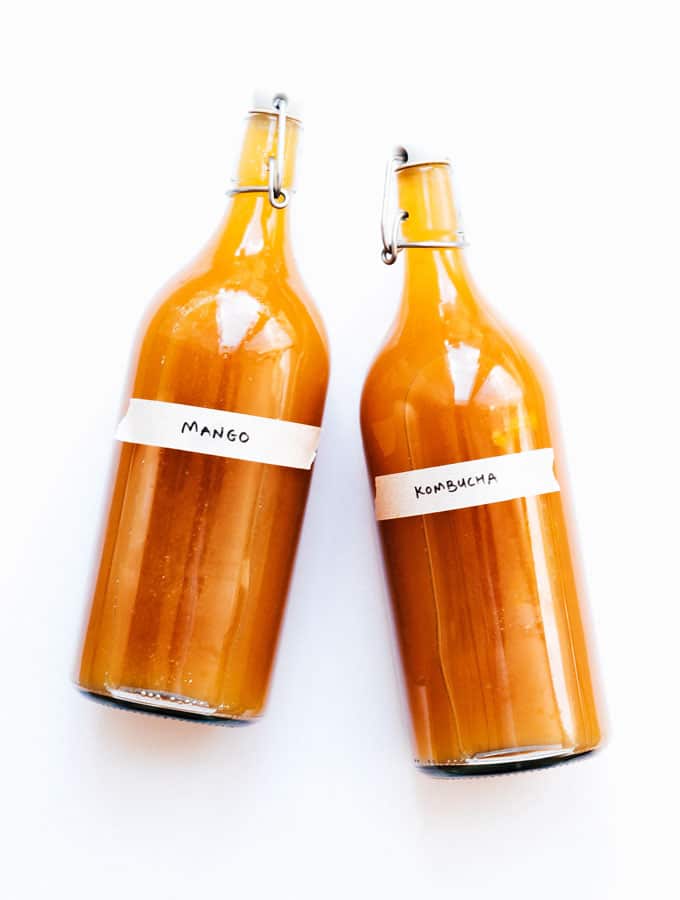
Flavoring homemade kombucha is such a fun yet suspenseful adventure. Because you can never be sure exactly how the flavors will transform over the fermentation process, and you have to wait a few days to find out!
You can go crazy with it (as in the case of tulip-man, who is currently perfecting his Jalapeno Ginger ‘Buch) or keep it simple with pureed fruit.
This Mango Kombucha errs on the simple side and is one of my favorite kombucha flavors! The sweet mango balances out the tart kombucha and transports me right to a beach on Hawaii, where I first ever tasted kombucha!
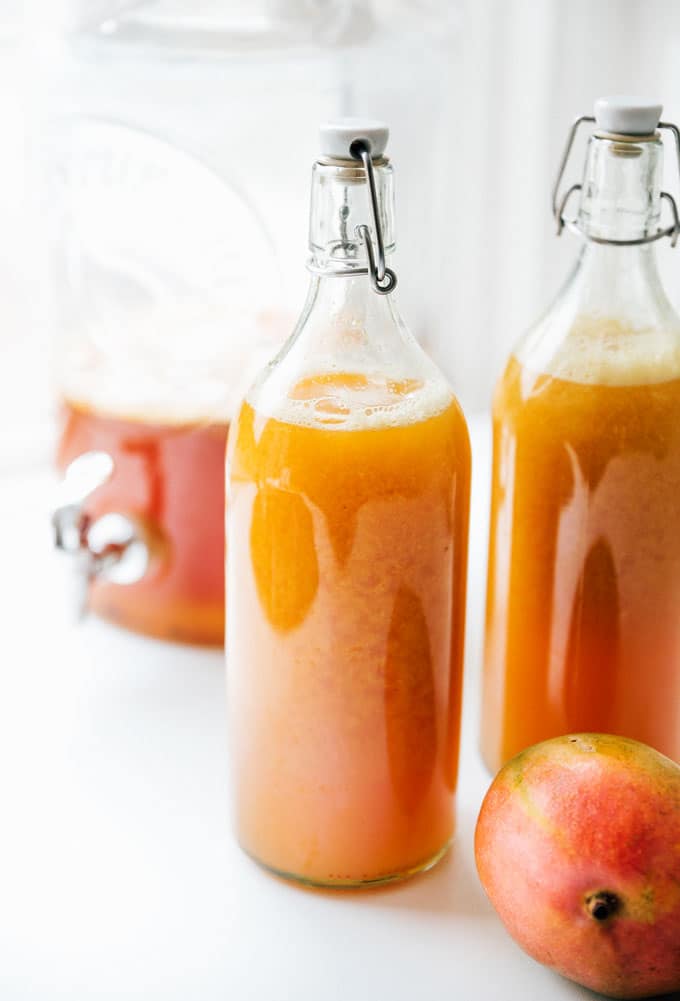
There are two main fermentation phases when making homemade kombucha:
- First Fermentation: This is when you transform sweet tea into tart and delicious kombucha (see our comprehensive guide to homemade kombucha here)
- Second Fermentation: This is when you carbonate the kombucha by adding sugars (like mango!) and bottling it.
In order to make this Mango Kombucha, you will need to have completed the first fermentation already and have some kombucha that’s ready to be carbonated! The video below shows you how to get to this point.

Ingredients to make Mango Kombucha
- Kombucha from a first fermentation: You’ve brewed your kombucha with the help of your SCOBY and it’s the perfect balance of sweet and tart (step-by-step first fermentation instructions here).
- Mango: You can use fresh or frozen mango to make kombucha!
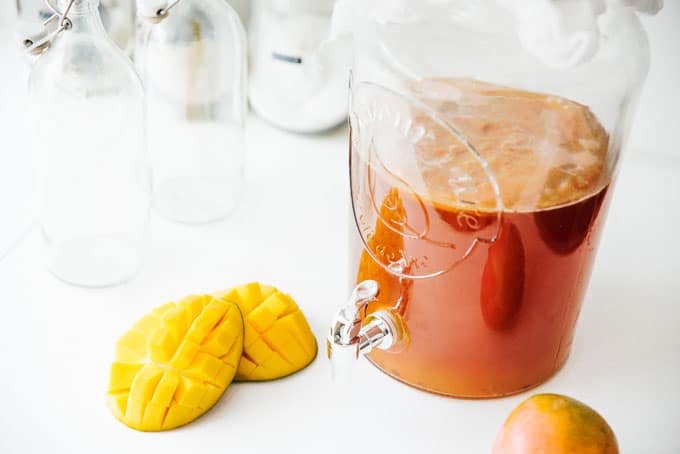
How to make mango kombucha
Making your own flavored kombucha with mango is super easy. The process goes something like this:
- Puree the mango: The more surface area of the fruit that is exposed to the tea, the more flavor and fizz you’ll have in the end!
- Mix: Stir together kombucha and mango to combine them well.
- Bottle: Transfer everything to fermentation bottles.
- Ferment: For 3 to 10 days, until it reaches the carbonation level you like.
- Enjoy: Strain out mango fibers (optional), then chill in the fridge before serving.
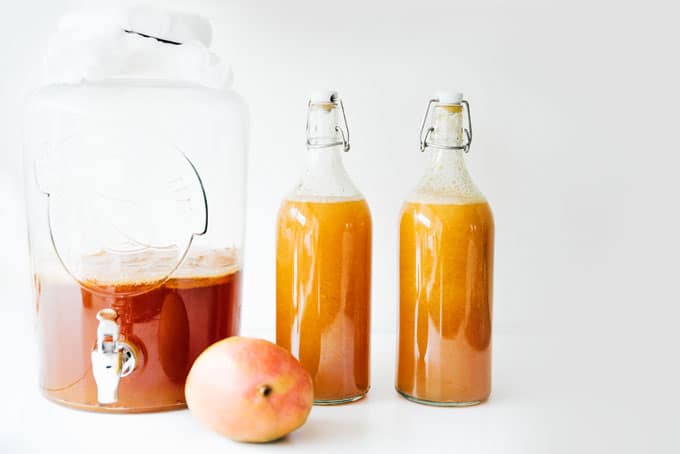
How long can you leave fresh fruit in kombucha?
The acidity of the kombucha will prevent the fruit from going bad! After you’ve carbonated your kombucha, store it in the fridge until ready to drink (it should last a few weeks).
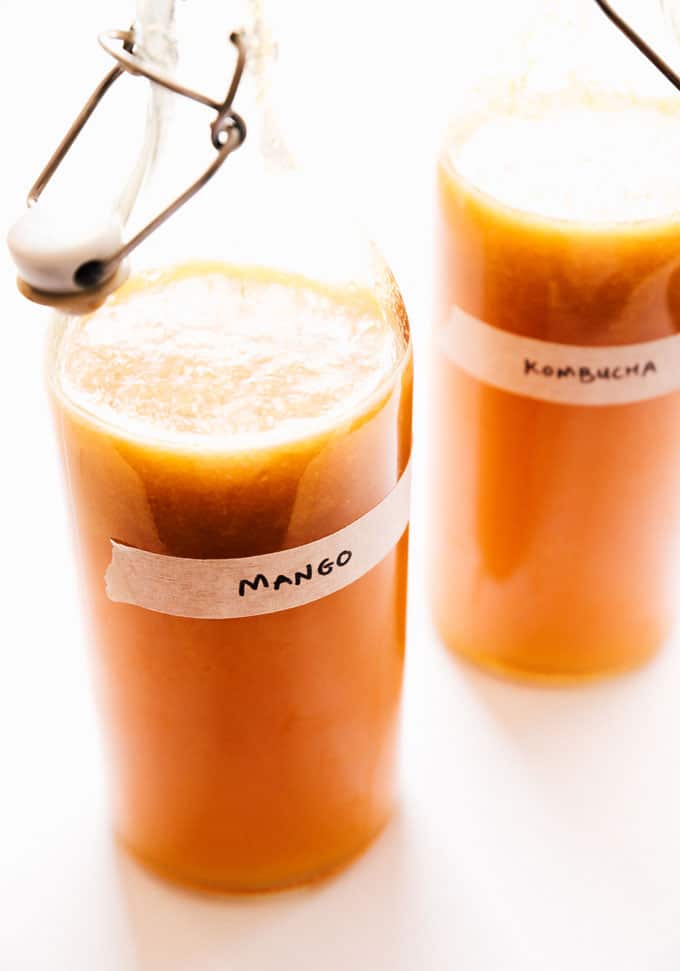
Can you use frozen fruit in kombucha?
You can use frozen fruit to make flavored kombucha! Be sure to thaw it first to prevent a temperature change from shocking or killing those good bacteria. I love using frozen fruit to make kombucha because it is usually more affordable, doesn’t depend on seasonality, and is already prepped for you!
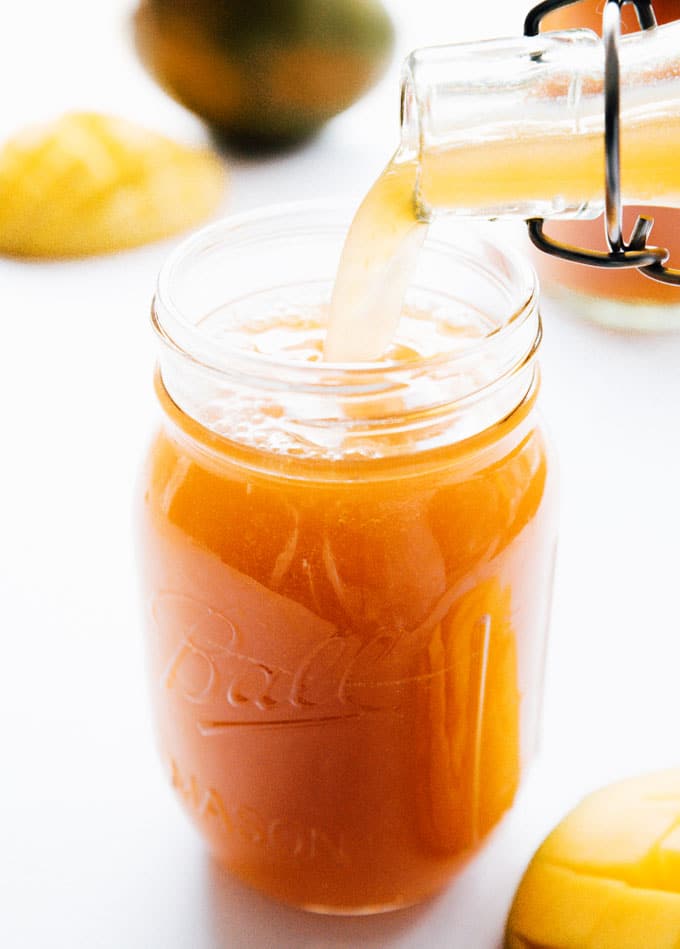
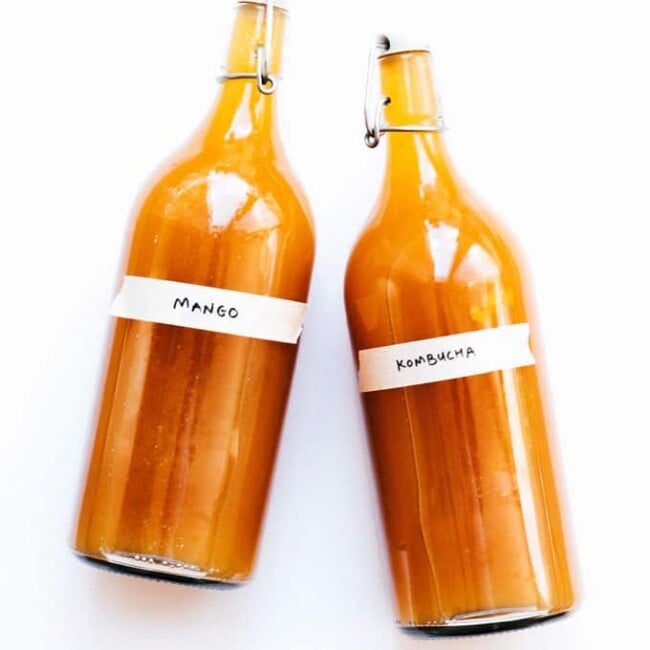
Ingredients
- ½ gallon kombucha from a first fermentation this is not storebought kombucha, 1.9 L
- 1 ripe mango about 2 cups frozen
Instructions
- Puree: Use a handheld immersion blender or countertop blender to puree mango into a smooth pulp.
- Mix: In a large glass bowl or pitcher, stir together pureed mango and kombucha.
- Bottle: Transfer kombucha into fermentation bottles*, leaving about 2 inches empty at the top. Seal tightly.
- Ferment: Place in a dark, room temperature area for 3 to 10 days, until it reaches the carbonation level you like. This process will go faster in warmer climates, and slower in cooler climates.
- Enjoy: Strain the kombucha to remove fibers (optional), then chill in the fridge before serving. Can be stored in the fridge, tightly sealed, for several weeks.
Tips & Tricks
Nutrition Information
More Kombucha Flavors To Try
Here are a few more of our favorite kombucha flavors (or check out our all-time favorite flavors here)
Zingy Raspberry Kombucha
A copycat inspired by the zingy Trilogy kombucha! (Recipe on our sister site, BrewBuch.com).
Chia Seed Kombucha
My favorite addition to kombucha...chia seeds! (Recipe on our sister site, BrewBuch.com).

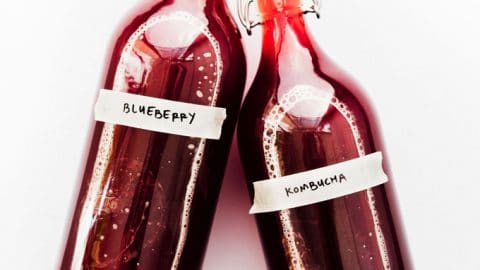

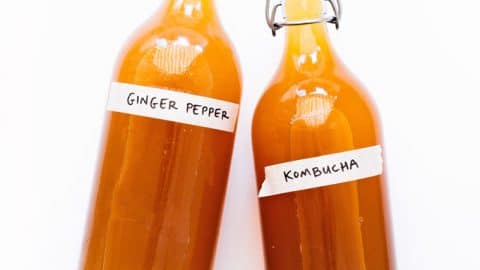
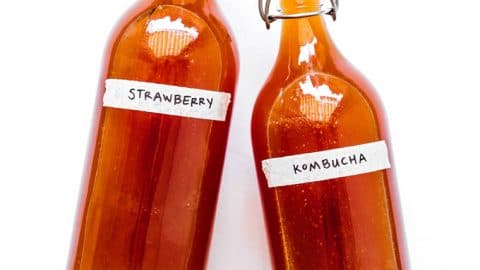
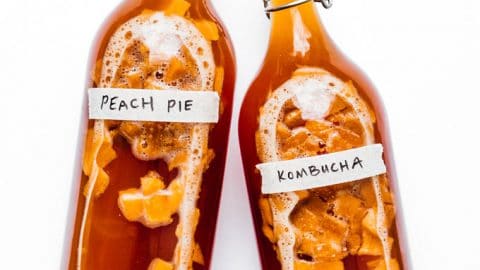


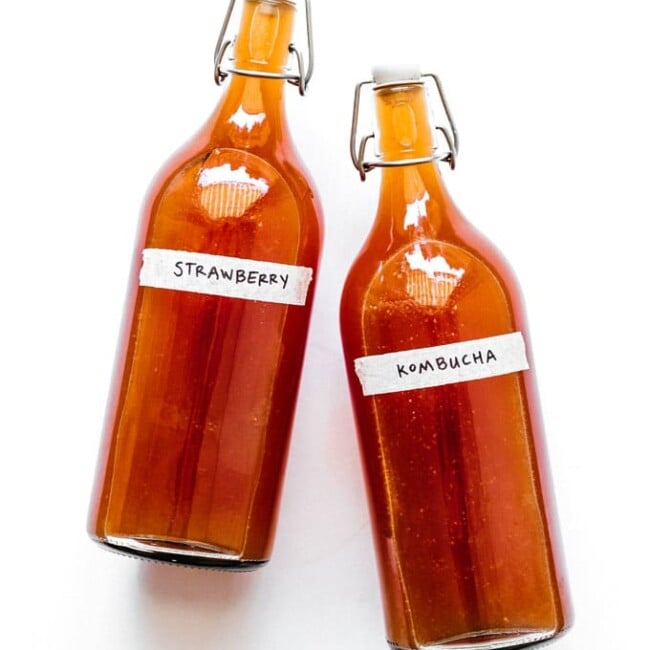
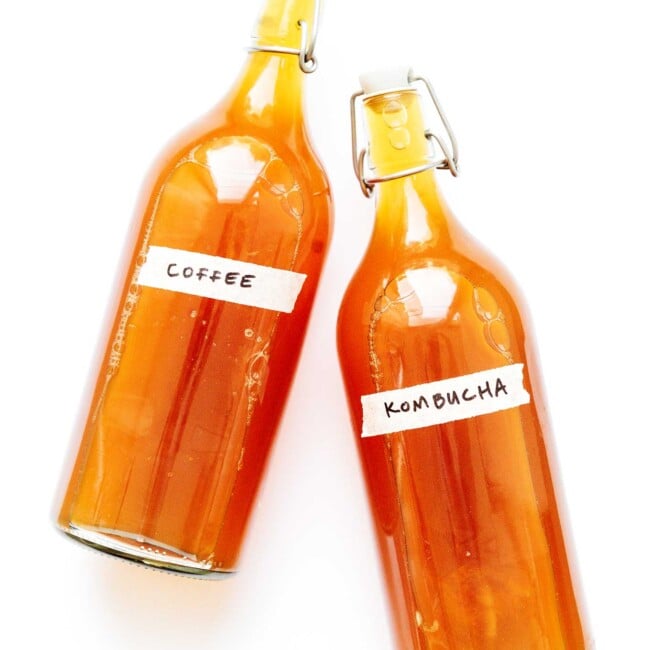
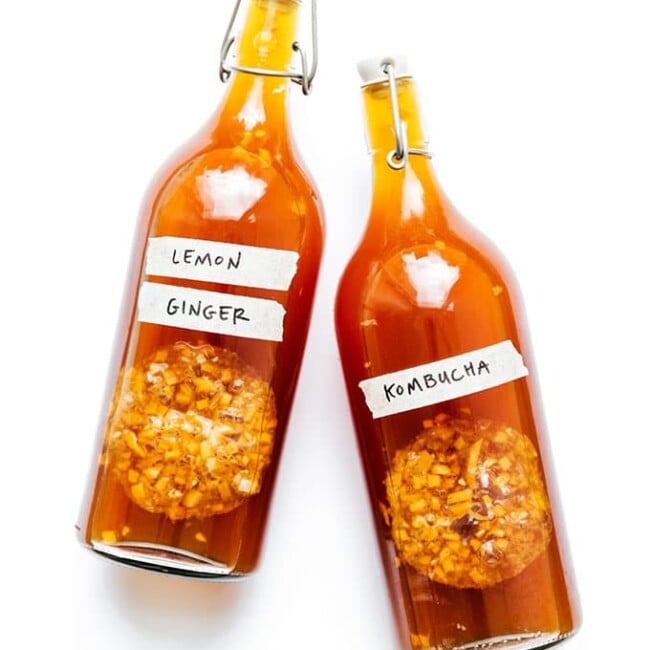
Jackie says
You are awesome! And soooo helpful!! I was wondering, do you lose a lot of the carbonation if you strain the fruit fibers after the second fermentation? And do you have any recommendations as far as which tea(s) and ratios to use?
Sarah says
Aw thanks Jackie! You may lose a little carbonation, but if you pour it back into closed bottles and let it sit for just a few hours it should be back to the same levels 🙂 I’ve actually only had the chance to try 100% black tea, but I’ll be trying mixing in some green tea soon! I’ve read 50/50 is a good ratio though!
Lawrence Frank Edder says
Your recipes look like they would be mighty yummy. My last three batches have been flavored with pomegranate juice. I pour the juice into the F1 jar, then into the F2 bottles. I let it sit for 7 days. The carbonation is perfection itself with a small bubble size. The flavor from the juice gives a sweet taste that isn’t over the top. In all, it’s a well balanced brew.
Sarah says
Yum, that sounds delish! I’ll have to try that on my next batch 😀
rohit aggarwal says
thank you liveeatlearn for giving me wonderful information
cheryl myers says
I have been looking at your flavored kombucha A lot of your recipes don’t tell you how much fruit to put in I’m new to this so i need some guidance as to how much fruit or juice to use Thank you
Sarah says
Hi Cheryl, all of our recipes should include the amount of fruit that you’ll need (this one you’ll need 1 mango, or about 2 cups diced). Let me know if you have a question about a specific recipe 😀
Jens says
Hello! At the moment I am trying to perfect my Mango Kombucha and I am a bit unsure about some things.
I live in south Spain so it is quite hot here at the moment, and I “only” leave my Kombucha for 8 days, but when tasting it, it is not sweet, although some times it already has some fizz.
For making the Mango Kombucha I use fresh mangos, that we fortunately can pick from the trees here. I have applied the logic for making jelly and similar using very mature fruit since mature fruit has more sugar. For 1 liter of kombucha I have been using pure from about 1,5 small mangos, that I would say is like a small cup of mango pure.
So far so god, but here comes my “problem”, my kombucha ferments a lot, and I mean a lot. I am leaving a lot space in the bottle, but after only 1 day I have to be really careful when opening the bottle or I will spray my kitchen with Mango Kombucha. From images I have seen some people uses a lot of fruit so I dont think that should be my problem. I have been considering that maybe I should let the first fermentation sit a bit longer, since it could be due to there still being too much sugar left in my Kombucha base.
At the moment I let the Mango Kombucha ferment 1 day and then I relieve the pressure and remove the white foam from the fruit (just like for jelly and similar) and let it continue to ferment. On the second day I strain out the Mango. After only 2 days the fizz is almost like a coke, so I am happy on that end. To get that real mango taste it still needs like 12-24 hours in the fridge.
I am happy with the fizz and taste, but I am not sure if I am using too much fruit, a too sweet Kombucha base, or if this is just normal, so comments are appreciated to keep on learning.
PS. Anyone uses any other fruit or species with their Mango Kombucha?
Sarah says
It sounds like you’re doing it all exactly right, actually! Your fizz is perfect, then you move it to the fridge to infuse the mango flavor more. That’s exactly what I would do!
Leaving it in the first fermentation longer would probably make it more fizzy (more bacteria and yeast to carbonate it), so I probably wouldn’t adjust the F1 length.
Deborah says
I made the mango one & love it. This was the first time making kombucha & my 2nd batch is ready to take the score out & I’m going to try the blueberry kombucha.
I’m so happy to have found the kick ass kombucha site.
Niobe says
LOVE IT!
LOVE YOU!
Ellen says
I tried this and there is a 2cm layer of what looks like mango puree on top. If I flip the bottle the layer flips too and stays on top. Is that normal?
Sarah Bond says
It sounds like a little SCOBY is forming – totally normal! You can discard it after fermentation.
Ellen says
Thanks Sarah for the recipe and reply! Take care 🙂
travis mercante says
I love this kombucha but the filtering process is much harder due to the fiberous nature of the mango – it gets clogged in any type of strainer or filter I try to use. By the time I am done filtering, all the carbonation is gone as well! Any suggestions on how to keep the carbonation, but lose the mango fibers?
Sarah Bond says
Perhaps filter it then put it back in the bottles for 1 more day of F2 to help regain that carbonation?
Naomi says
Can I use 100% only mango juice (no added sugars or anything) for this recipe? How much juice would I add? Thank you!
Sarah Bond says
Yes you can! I would use 1/2 to 1 cup 🙂
Sylvia says
Very helpful. I live on Kauai where we have an abundance of fresh tropical fruit with which to experiment. Mahalo.:)
Mark harrington says
Greetings from Colorado! I’m making my first ever batch of Kombucha using a kit containing the scoby. 7 days in the PH reads 3.5 on digital meter and the tea is slightly sweet with no detectable vinegar flavor. The gallon jug has a film on top of the liquid sort of whitish In color but not moldy looking. The bottom of the jar sits the original scoby with what looks like a new layer. Is this ready for second fermentation based on the PH? Do I discard the top growth but retain the original scoby. The top growth does cover the circumference of the wide mouth gallon jug so is not smaller like the original scoby.
Sarah Bond says
I would leave the top growth, that’s just more SCOBY. Moving onto the second fermentation should be based almost entirely on taste – when it’s the combination of sweet and tart that you like, then bottle it! Could take a little longer with the weather getting colder 😀
Chantelle says
I bought my scoby for a local health food store. I did my first brew, and then put the scoby in the fridge bcus I had alot of brew to drink. I took scoby (and small baby) out of fridge and brought to room temperature again, and did another brew like I did the first time. Would this be considered the “first brew” or “second brew”, bcus it came out of fridge??? I want to make mango kombucha but not sure if I’m on the second brew or first brew due to having it in fridge. Thank you!!
Sarah Bond says
It sounds like you did the first fermentation! You can now transfer the kombucha into bottles, add mango, and do the second fermentation 😀
Clare Allen says
Wonderful instructions for making Kombucha and great flavour suggestions. Thank you very much. I have made my own Scobie using your recipe and was astonished when it worked. I have used a collection of old jars that I had lying around which I sterilised with boiling water so the whole thing has cost almost nothing. My first batch with lemon was tasty but very sour. The next batch with orange & ginger was delicious. I have mango, ginger + cinnamon bubbling away as my next experiment. I have grapes and ginger in another jar. I keep them in the jars which are not sealed enough to explode which is a comfort! The kombucha is still lightly fizzy and I love it. Sometimes I mix with a little carbonated water. Every week I make a bowl of sweet tea as per your recipe. Then I pour the kombucha out of its jar, leaving the Scobie and some liquid behind and pour in more tea. I don’t even bother to sieve it. The liquid I poured off, I flavour and leave for 5 days in a new jar before putting in the fridge. It is so easy done this way. Lazy person’s Kombucha. They bubble away in my airing cupboard like a group of little pets! They are obviously happy there which is ridiculously satisfying. Thank you again for this seriously easy to use set of instructions.
Cathe says
Can’t wait to try this recipe!! It’s my favorite flavor of kombucha!!
Thanks for sharing your recipes!!
Laura says
Thank you so much for your instructions! For this recipe, did you use black or green tea in F1?
Sarah Bond says
I used black tea, but green would also work well here! 😀